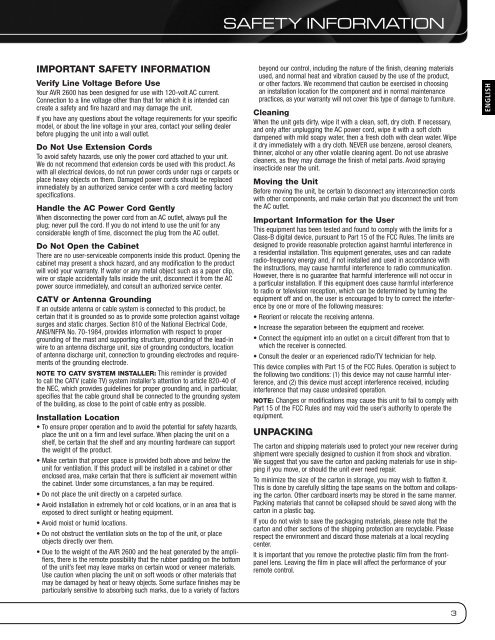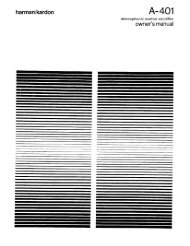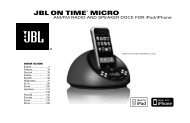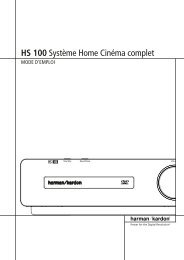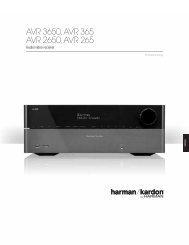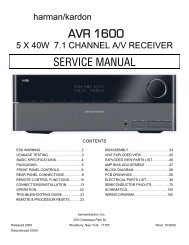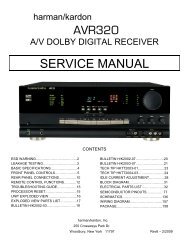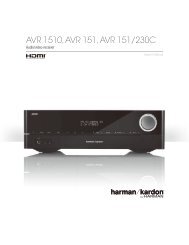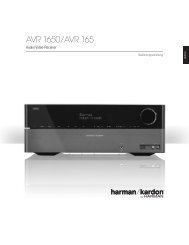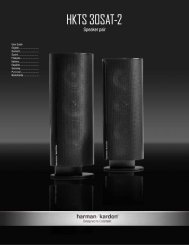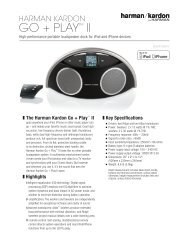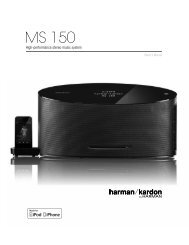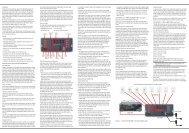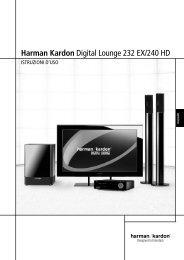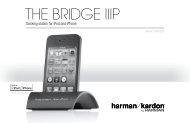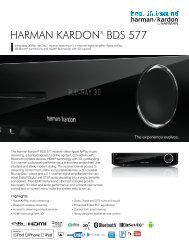Create successful ePaper yourself
Turn your PDF publications into a flip-book with our unique Google optimized e-Paper software.
SAFETY INFORMATION<br />
IMPORTANT SAFETY INFORMATION<br />
Verify Line Voltage Before Use<br />
Your <strong>AVR</strong> <strong>2600</strong> has been designed for use with 120-volt AC current.<br />
Connection to a line voltage other than that for which it is intended can<br />
create a safety and fire hazard and may damage the unit.<br />
If you have any questions about the voltage requirements for your specific<br />
model, or about the line voltage in your area, contact your selling dealer<br />
before plugging the unit into a wall outlet.<br />
Do Not Use Extension Cords<br />
To avoid safety hazards, use only the power cord attached to your unit.<br />
We do not recommend that extension cords be used with this product. As<br />
with all electrical devices, do not run power cords under rugs or carpets or<br />
place heavy objects on them. Damaged power cords should be replaced<br />
immediately by an authorized service center with a cord meeting factory<br />
specifications.<br />
Handle the AC Power Cord Gently<br />
When disconnecting the power cord from an AC outlet, always pull the<br />
plug; never pull the cord. If you do not intend to use the unit for any<br />
considerable length of time, disconnect the plug from the AC outlet.<br />
Do Not Open the Cabinet<br />
There are no user-serviceable components inside this product. Opening the<br />
cabinet may present a shock hazard, and any modification to the product<br />
will void your warranty. If water or any metal object such as a paper clip,<br />
wire or staple accidentally falls inside the unit, disconnect it from the AC<br />
power source immediately, and consult an authorized service center.<br />
CATV or Antenna Grounding<br />
If an outside antenna or cable system is connected to this product, be<br />
certain that it is grounded so as to provide some protection against voltage<br />
surges and static charges. Section 810 of the National Electrical Code,<br />
ANSI/NFPA No. 70-1984, provides information with respect to proper<br />
grounding of the mast and supporting structure, grounding of the lead-in<br />
wire to an antenna discharge unit, size of grounding conductors, location<br />
of antenna discharge unit, connection to grounding electrodes and requirements<br />
of the grounding electrode.<br />
NOTE TO CATV SYSTEM INSTALLER: This reminder is provided<br />
to call the CATV (cable TV) system installer’s attention to article 820-40 of<br />
the NEC, which provides guidelines for proper grounding and, in particular,<br />
specifies that the cable ground shall be connected to the grounding system<br />
of the building, as close to the point of cable entry as possible.<br />
Installation Location<br />
• To ensure proper operation and to avoid the potential for safety hazards,<br />
place the unit on a firm and level surface. When placing the unit on a<br />
shelf, be certain that the shelf and any mounting hardware can support<br />
the weight of the product.<br />
• Make certain that proper space is provided both above and below the<br />
unit for ventilation. If this product will be installed in a cabinet or other<br />
enclosed area, make certain that there is sufficient air movement within<br />
the cabinet. Under some circumstances, a fan may be required.<br />
• Do not place the unit directly on a carpeted surface.<br />
• Avoid installation in extremely hot or cold locations, or in an area that is<br />
exposed to direct sunlight or heating equipment.<br />
• Avoid moist or humid locations.<br />
• Do not obstruct the ventilation slots on the top of the unit, or place<br />
objects directly over them.<br />
• Due to the weight of the <strong>AVR</strong> <strong>2600</strong> and the heat generated by the amplifiers,<br />
there is the remote possibility that the rubber padding on the bottom<br />
of the unit’s feet may leave marks on certain wood or veneer materials.<br />
Use caution when placing the unit on soft woods or other materials that<br />
may be damaged by heat or heavy objects. Some surface finishes may be<br />
particularly sensitive to absorbing such marks, due to a variety of factors<br />
beyond our control, including the nature of the finish, cleaning materials<br />
used, and normal heat and vibration caused by the use of the product,<br />
or other factors. We recommend that caution be exercised in choosing<br />
an installation location for the component and in normal maintenance<br />
practices, as your warranty will not cover this type of damage to furniture.<br />
Cleaning<br />
When the unit gets dirty, wipe it with a clean, soft, dry cloth. If necessary,<br />
and only after unplugging the AC power cord, wipe it with a soft cloth<br />
dampened with mild soapy water, then a fresh cloth with clean water. Wipe<br />
it dry immediately with a dry cloth. NEVER use benzene, aerosol cleaners,<br />
thinner, alcohol or any other volatile cleaning agent. Do not use abrasive<br />
cleaners, as they may damage the finish of metal parts. Avoid spraying<br />
insecticide near the unit.<br />
Moving the Unit<br />
Before moving the unit, be certain to disconnect any interconnection cords<br />
with other components, and make certain that you disconnect the unit from<br />
the AC outlet.<br />
Important Information for the User<br />
This equipment has been tested and found to comply with the limits for a<br />
Class-B digital device, pursuant to Part 15 of the FCC Rules. The limits are<br />
designed to provide reasonable protection against harmful interference in<br />
a residential installation. This equipment generates, uses and can radiate<br />
radio-frequency energy and, if not installed and used in accordance with<br />
the instructions, may cause harmful interference to radio communication.<br />
However, there is no guarantee that harmful interference will not occur in<br />
a particular installation. If this equipment does cause harmful interference<br />
to radio or television reception, which can be determined by turning the<br />
equipment off and on, the user is encouraged to try to correct the interference<br />
by one or more of the following measures:<br />
• Reorient or relocate the receiving antenna.<br />
• Increase the separation between the equipment and receiver.<br />
• Connect the equipment into an outlet on a circuit different from that to<br />
which the receiver is connected.<br />
• Consult the dealer or an experienced radio/TV technician for help.<br />
This device complies with Part 15 of the FCC Rules. Operation is subject to<br />
the following two conditions: (1) this device may not cause harmful interference,<br />
and (2) this device must accept interference received, including<br />
interference that may cause undesired operation.<br />
NOTE: Changes or modifications may cause this unit to fail to comply with<br />
Part 15 of the FCC Rules and may void the user’s authority to operate the<br />
equipment.<br />
UNPACKING<br />
The carton and shipping materials used to protect your new receiver during<br />
shipment were specially designed to cushion it from shock and vibration.<br />
We suggest that you save the carton and packing materials for use in shipping<br />
if you move, or should the unit ever need repair.<br />
To minimize the size of the carton in storage, you may wish to flatten it.<br />
This is done by carefully slitting the tape seams on the bottom and collapsing<br />
the carton. Other cardboard inserts may be stored in the same manner.<br />
Packing materials that cannot be collapsed should be saved along with the<br />
carton in a plastic bag.<br />
If you do not wish to save the packaging materials, please note that the<br />
carton and other sections of the shipping protection are recyclable. Please<br />
respect the environment and discard those materials at a local recycling<br />
center.<br />
It is important that you remove the protective plastic film from the frontpanel<br />
lens. Leaving the film in place will affect the performance of your<br />
remote control.<br />
ENGLISH<br />
3


